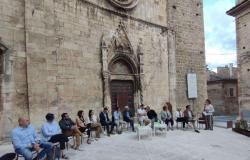Castles, fortresses, villas, parks and gardens open to visitors free of charge: the national day of the Italian Historic Houses association is back. The largest widespread museum in Italy reopens its doors, showcasing monuments including castles, fortresses, villas, parks and gardens along the entire peninsula. They will welcome free of charge all those who want to immerse themselves in timeless places, surrounded by the wonders of the Italian artistic and cultural heritage. . In Abruzzo there are 28 historic homes open to visits on the occasion of the 14th national day of the Adsi (National Association of Historic Homes). With a journey that goes from the frescoes of Raphael’s school to the Summa artist studio. It is an important heritage, which the owners safeguard with dedication and commitment and which contributes to forming the largest widespread museum present in the national territory. «In Italy there are over 8,200 private homes usually open to the public», underlines the president of Adsi Abruzzo, Giovanni Ciarrocca, «far exceeding the number of Italian municipalities, which amount to 7,901: on average, more than one home per locality . Historic homes represent the largest cultural industry in the country, creating economy and social value in the sectors of craft tourism and restoration.”
In fact, 28% of the homes are located in municipalities with less than 5,000 inhabitants, over half (54%) are located in inhabited centers with less than 20,000 inhabitants and 31.3% in peri-urban areas or outside the cities. Furthermore, more than one home in three appears to be within a historic village, one in four in a rural area. Residences are non-relocatable assets that generate social value and an economy inextricably linked to the territory. If adequately valorised, they can therefore represent a stimulus for the restart of small municipalities, guaranteeing a positive return for local productive activities which are increasingly in difficulty. The internal areas – equal to 58% of the country, where 13 million people live – are increasingly poor and devoid of services due to depopulation that goes well beyond the current demographic decline.
Not only that, in recent years there has been a growth in the spending capacity of short-medium range tourism: proximity tourism in the villages represents an additional opportunity to enhance and preserve the cultural and natural heritage. But this year the city of Pescara is also enriched with two jewels, the Summa Foundation and the Imago Museum, just as Palazzo Margherita will be opened in L’Aquila for the first time. Below is the list of historic homes that can be visited.
Province of Pescara. Summa Foundation, Imago Museum, Pescarabruzzo Foundation. Paparella Foundation, Villa Basile Park (Pescara), Convent of San Panfilo (Spoltore).
Province of CHIETi.Palazzo Tilli (Casoli) Palazzo Mayer (Fossacesia).
Province of L’Aquila. Palazzo D’Alessandro, Caporciano, Oratory of Sant’Antonio of the knights de Nardis and Palazzo de Nardis, Palazzo Ciolina, Grancia dei Celestini formerly the convent of Santa Lucia century. XIII – ). Palazzo Vitto Massei (Pettorano sul Gizio) Palazzo Sipari complex (Pescasseroli). Palazzo Ciarrocca, (Santo Stefano di Sessanio)
Province of TERAMO. Civic Art Gallery “Vincenzo Bindi” House Museum (Giulianova) Villa Rossi (Silvi)
For Latest Updates Follow us on Google News






